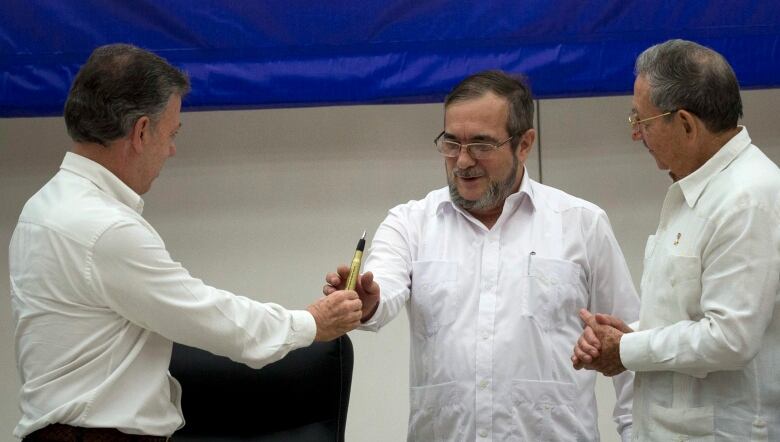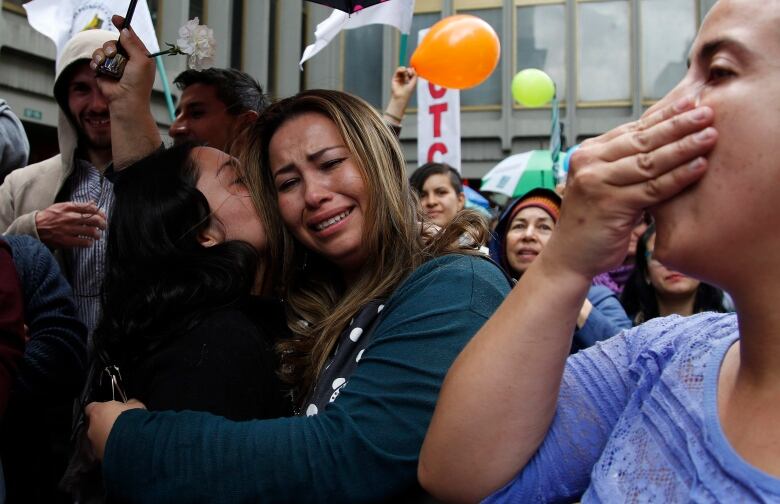Colombia signs ceasefire with rebels
'We don't have even the slightest memories of what it means to live in peace,' president says

Colombian President Juan Manuel Santos and the head of the country's leftist FARC rebels agreed Thursday on a ceasefire and rebel disarmament deal that moves the country to the brink of ending a 52-year war that has left more than 220,000 people dead.
At a ceremony in Havana, Cuba,Santos and FARC commander Rodrigo Londono, better known as Timochenko, watched as their lead negotiators signed a deal laying out how 7,000 rebel fighters will demobilize and hand over their weapons after the signing of a final peace accord as early as next month. UN Secretary General Ban Ki-moon, a special U.S. envoy and the presidents of Cuba, Chile and Venezuela and other Latin American countries applauded the signing.
- Colombia takes last step towards ceasefire with rebels
- Colombia's president and FARC rebel commander commit to peace agreement within 6 months
In the Colombian capital, Bogota, hundreds of people watched the ceremony live on a giant screen, hugging each other, singing the national anthem and waving the Colombian flag. Some cried.
"Colombia got used to living in conflict. We don't have even the slightest memories of what it means to live in peace," Santos said.
"Today a new chapter opens, one that brings back peace and gives our children the possibility of not reliving history."
A 15-year, U.S.-backed military offensive thinned rebel ranks and forced FARC's aging leaders to the negotiating table in 2012. In Santos, a U.S.-educated economist and scion of one of Colombia's richest families, the rebels found a trusted partner who hailed from the conservative elite but wasn't bound by its prejudices.

"The Colombian armed forces that grew enormous during the war are now called to play an important role in peace," Timochenko said. "They were our adversaries, but going forward they'll be our allies."
Momentum had been building toward a breakthrough after Santos said this week that he hoped to deliver a peace accord in time to mark Colombia's declaration of independence from Spain on July 20.
But the latest agreement went further than expected.
In addition to a framework for the ceasefire, both sides agreed on a demobilization plan that will see guerrillas concentrate in rural areas and hand over weapons that had long been the vaunted symbols of their movement's origins as a self-defence force of peasant farmers attacked by the oligarchy-controlled state.
"This is historic, a great hope for Colombia," said Jimmy Gonzalez, a 36-year-old hotel worker. "Let this end the spilling of blood that's affected us for so many years."
The deal does not mark the start of a ceasefire, which would only begin with the signing of a final peace deal. It requires the rebels to completely put down their arms at most six months after the signing of the final accord, which Santos said would take place in Colombia.
A day after the signing of the final deal, the Colombian army will reposition troops to protect FARC fighters as they move to their transition zones within five days. FARC fighters will move to23 zones and eight camps where they will leave their arms and begin the process of moving back into civilian life. The arms will be delivered to United Nations monitors, who will use them to build three monuments to peace, according to the deal.

Security guarantees
The accord includes security guarantees for the FARC during its planned transition to a peaceful political party. A similar attempt in the 1980s led to thousands of rebels and their sympathizers being killed by paramilitaries and corrupt soldiers.
A few relatively minor items remain to be worked out for a peace accord. The biggest is how the final deal will be ratified and given legal armour so it won't unravel should a more conservative government succeed Santos, who leaves office in 2018.
Santos has also promised to let Colombians vote on accepting the final accord in a national referendum, and his government isn't taking acceptance for granted.
A peace deal won't make Colombia safer overnight.
The proliferation of cocaine fuelled a conflict longer than any other in Latin America and will remain a powerful magnet for criminal gangs operating in Colombia's remote valleys and lawless jungles. Colombia is the largest supplier of cocaine to the U.S. and only a small fraction of the country's 12,000-plus homicides last year had anything to do with the conflict.
"Although hard work remains to be done, the finish line is approaching and nearer now than it has ever been," U.S. Secretary of State John Kerry said in a statement from Washington.
There is also the risk that the country's second rebel movement, the much-smaller but more recalcitrant National Liberation Army, could fill the void left by the FARC. That rebel group agreed to negotiations with the government earlier this year but those talks have yet to start because of Santos's insistence that it renounce kidnapping.
But if FARC members honour their commitments and the fighters are successfully integrated back into society, the government could begin shifting resources away from the battlefield and toward attacking other forms of crime and the crushing poverty and inequality that it feeds on.












_(720p).jpg)


 OFFICIAL HD MUSIC VIDEO.jpg)
.jpg)



























































































